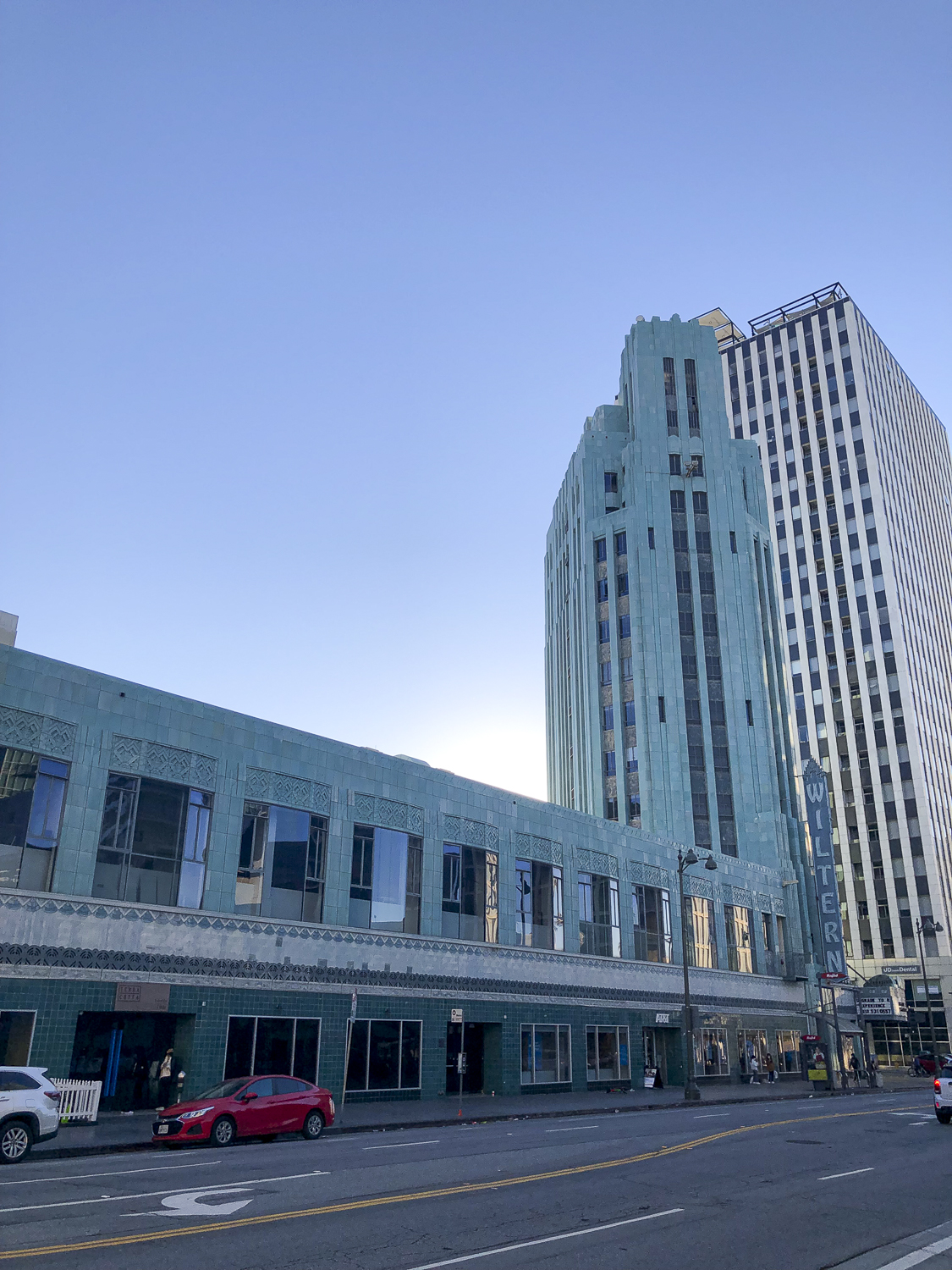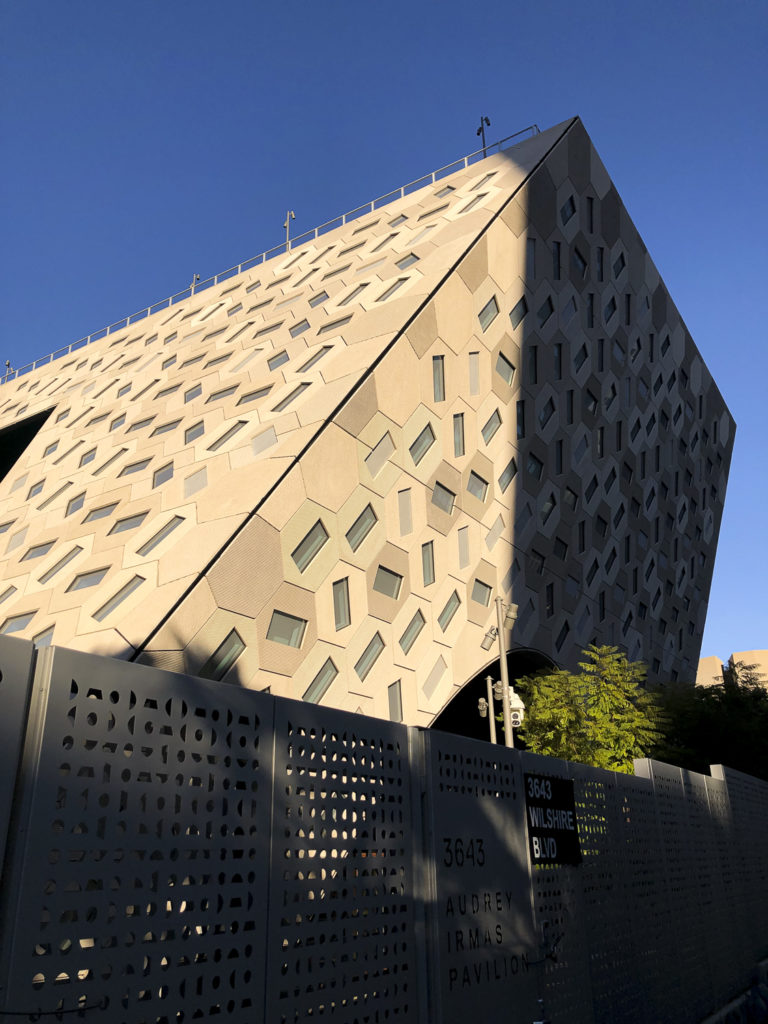“It is here that you enter the urban canyon that is Wilshire Boulevard, feeling a sense of the city’s majesty, dwarfed as a pedestrian by buildings standing shoulder to shoulder for blocks on end.”
A flâneur takes to the streets, uncovering surprises — both modest and startling — on walks through a city that’s reinventing itself around every corner.
The urban canyon, found so readily in Manhattan, is a rarity here in Los Angeles. Yes, you can find it downtown, but there is a pinched quality to it, where traffic and bike lanes compete to share the road. The sidewalks are also often crowded with goods spilling out from storefronts — as well as the fine citizens of Los Angeles, drawn by those same offerings and clotting together at crosswalks. The ideal urban canyon has a wide boulevard coursing through it, cutting its way like a river through the buildings lining either side of it, which in turn cast shadows across the street at all hours of the day except high noon.
On a recent Sunday afternoon, I parked my car on the eastern side of the Bullocks Wilshire building — now occupied by Southwestern Law School — and craned to look through the slotted security gates to the still grand entryway. For a moment, I wished to be transported back to when this was the greatest department store in Los Angeles, to take an elevator to its topmost floor for a view out along the Wilshire corridor. The Bullocks Wilshire tower has always presented a question for the practically minded: What did these various floors contain when they are too small for retail displays? Perhaps the answer is as mundane as office space, but even if it has no practical purpose, the tower allows the building, which looks so solid and earthbound on its lower levels, to soar, climbing to the heights of art deco.
I round the corner onto Wilshire, peering inside the street-level windows into what could be a Hollywood set for a law school, each library table joined by six matching wooden chairs, individual reading lamps sprouting from the middle of the tables. Rows and rows of reference books stand nearby, every single one in its rightful place. There are even points where the tables stretch off into the depths of the building, suggesting a readiness for study that is countered only by the fact that there is not a single person visible within. It is, in fact, a bit ghostly, even in the perfect golden light of the afternoon. I finally look away in the hopes of not spotting anyone to clutter the image.
In detail: the Bullocks Wilshire building — now occupied by Southwestern Law School. Photos by Lincoln Wheeler.
It is here that you enter the urban canyon that is Wilshire Boulevard, feeling a sense of the city’s majesty, dwarfed as a pedestrian by buildings standing shoulder to shoulder for blocks on end. Many of the office buildings that predominate along here are basically glass boxes, their window frames forming grids and mirroring the city across their faces. These structures, emerging from the ‘60s and ‘70s, are now joined by a multitude of new apartment buildings advertising their youthful appeal in the form of brightly-colored panels affixed to their balconies, the citrus lemons and oranges of one building dueling with the apple reds of another. They flirt with the 20-somethings who have made Koreatown such a destination in L.A., asking them to not only spend their dining and drinking hours here but to lie down in them at night.
Amidst all this scale, I have an unexpected feeling of security, as if the windows and walls along Wilshire are in fact offering a shield against the world outside. An almost balmy breeze courses past, as if porting in from Wilshire’s western origins above the beaches of Santa Monica.
With less movement across the city during the pandemic, I have, at times, been surprised to discover a new building has been erected as though it unfolded itself in place overnight, with none of the recurrent clank and grind of construction crews to make you think, “Finally!” when completed. Two blocks west of the Line Hotel is one such revelation, the Audrey Irmas Pavilion, with its facade leaning outward toward the street, looking very much like a multi-faceted jewel. I initially thought of the hive-like exterior of The Broad, as the pavilion has such a multitude of windows inset at various angles: They are upright, they are sideways, they are diagonal, some are even outlined as windows but filled in with cement. My eyes played across it, trying to put some order to it, but it’s the random placement that is to be enjoyed, like an unsolved puzzle with all its pieces permanently fixed in place. Cut into its center and facing Harvard Boulevard is a large picture window spanning a couple of floors and outlined in reflective tiles of forest green. Looking upward, there is a roof garden with young tree branches beginning to spread aloft. It is a statement building — but subtle, modestly sized in comparison to so many other buildings along this stretch. Even the concrete box planters that line the parkway along Harvard are set askew as if they’ve fallen from the windows above to land on the soft damp earth.
The multi-faceted facade of the Audrey Irmas Pavilion on Wilshire Boulevard. Photos by Lincoln Wheeler.
The Audrey Irmas Pavilion stands alongside the Wilshire Boulevard Temple and is only a block away from St. Basil Catholic Church, a modernist construction lined on the exterior with abstract stained glass designs. Churches representing many eras of L.A.’s architectural styles are part of the reach to the sky here. Even on this relatively short stretch, you are drawn into the history of the city, whether you are looking at the Cocoanut Grove Theatre, a vestige of the long-gone Ambassador Hotel, the site of Robert Kennedy’s assassination in 1968, now dwarfed by the high school building behind it. Or just across Wilshire at the HMS Bounty, a drinker’s lair where it always feels like nighttime inside, even at noon.

The marker to end your trip down this canyon is the Wiltern, a different kind of temple, this one dedicated to nightlife and live music. If you have crossed the threshold of the Wiltern amidst a crush of concert-goers, you’ll know that it can be hard to linger under its marquee or pause to admire the deco sunburst that radiates out from above the ticket stand. I have walked underneath it many times, but it wasn’t until this afternoon that I really took it in, with great appreciation for those that would have envisioned such an entry point for attendees already looking forward to a night of entertainment to come. The sun still appears to be rising at the Wiltern, 90 years after it was built and bookending this stretch of Wilshire with its art deco cousin to the east at Bullocks Wilshire.
After this trip along 100 years or more of L.A. history, vault yourself into the present by crossing Wilshire and heading two blocks north along the great melting pot that is Western Avenue to Bumsan Organic Milk Bar. It’s a rather heady name for what is essentially a great place for soft serve. While it draws a steady enough stream of customers, you’ll rarely encounter a line — though its excellence deserves more disciples. But be grateful for the quick service. It’s the twist you want, the one I crave, usually combining one of Bumsan’s classics with a seasonal flavor. Right now, you can swirl your way through taro milk tea & pink guava, chocolate & pineapple mango, or what seem like two modern-day classics: true milk & matcha. As I write this, my hand is stretching out toward my car keys, toward a cone studded on its rim with Fruity Pebbles and for a view down Western toward the tower at the Wiltern, aqua blue in the last light of day.
Editor’s Note: A previous version of this story mistakenly referred to the Audrey Irmas Pavilion as the Wallis Annenberg GenSpace. The Wallis Annenberg GenSpace is actually housed inside the Audrey Irmas Pavilion.





